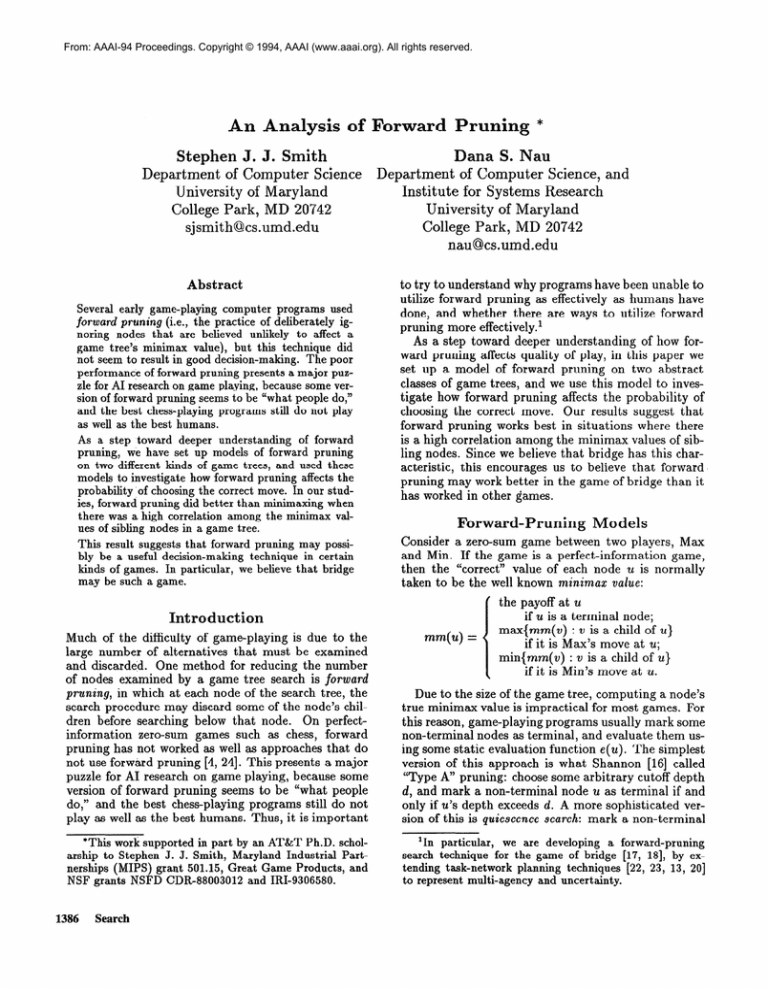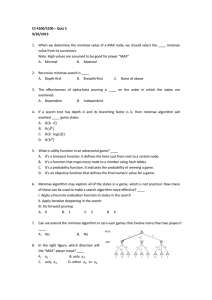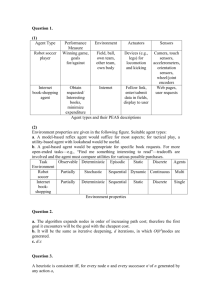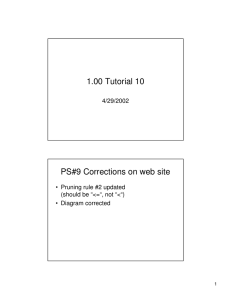
From: AAAI-94 Proceedings. Copyright © 1994, AAAI (www.aaai.org). All rights reserved.
An Analysis of Forward Pruning *
Stephen J. J. Smith
Department of Computer Science
University of Maryland
College Park, MD 20742
sjsmithQcs.umd.edu
Abstract
Several
early
game-playing
computer
programs
used
of deliberately
ignoring nodes that are believed unlikely to affect a
game tree’s minimax
value), but this technique did
not seem to result in good decision-making.
The poor
performance
of forward pruning presents a major puzzle for AI research on game playing, because some version of forward pruning seems to be “what people do,”
and the best chess-playing
programs still do not play
as well as the best humans.
forward pruning (i.e., the practice
As a step toward deeper understanding
of forward
pruning, we have set up models of forward pruning
on two different kinds of game trees, and used these
models to investigate how forward pruning affects the
probability of choosing the correct move. In our studies, forward pruning did better than minimaxing when
there was a high correlation
among the minimax values of sibling nodes in a game tree.
This result suggests that forward pruning may possibly be a useful decision-making
technique in certain
we believe that bridge
kinds of games. In particular,
may be such a game.
Dana S. Nau
Department of Computer Science, and
Institute for Systems Research
University of Maryland
College Park, MD 20742
nau@cs.umd.edu
to try to understand
why programs have been unable to
utilize forward pruning as effectively as -humans have
done, and whether there are ways to utilize forward
pruning more effective1y.l
As a step toward deeper understanding
of how forward pruning affects quality of play, in this paper we
set up a model of forward pruning
on two abstract
classes of game trees, and we use this model to investigate how forward pruning affects the probability
of
choosing the correct move. Our results suggest that
forward pruning works best in situations
where there
is a high correlation
among the minimax values of sibling nodes. Since we believe that bridge has this characteristic,
this encourages
us to believe that forward
pruning may work better in the game of bridge than it
has worked in other games.
Forward-Pruning
Models
Consider a zero-sum game between two players, Max
and Min. If the game is a perfect-information
game,
then the “correct” value of each node u is normally
taken to be the well known minimax value:
Introduction
mm(u)
=
the payoff at u
if u is a terminal node;
max(mm(v)
: v is a child of u)
if it is Max’s move at u;
min(mm(v)
: v is a child of b}
if it is Min’s move at u.
Much of the difficulty of game-playing
is due to the
large number of alternatives
that must be examined
and discarded.
One method for reducing the number
of nodes examined by a game tree search is forward
pruning, in which at each node of the search tree, the
search procedure may discard some of the node’s children before searching below that node.
On perfectinformation
zero-sum games such as chess, forward
pruning has not worked as well as approaches that do
not use forward pruning [4, 241. This presents a major
puzzle for AI research on game playing, because some
version of forward pruning seems to be “what people
do,” and the best chess-playing
programs still do not
play as well as the best humans. Thus, it is important
Due to the size of the game tree, computing
a node’s
true minimax value is impractical
for most games. For
this reason, game-playing
programs usually mark some
non-terminal
nodes as terminal, and evaluate them using some static evaluation function e(u). The simplest
version of this approach is what Shannon
[16] called
“Type A” pruning: choose some arbitrary
cutoff depth
d, and mark a non-terminal
node u as terminal if and
only if u’s depth exceeds d. A more sophisticated
version of this is quiescence search: mark a non-terminal
*This work supported in part by an AT&T Ph.D. scholarship to Stephen J. J. Smith, Maryland
Industrial
Partnerships (MIPS) grant 501.15, Great Game Products,
and
NSF grants NSFD CDR-88003012
and IRI-9306580.
‘In particular,
we are developing
a forward-pruning
search technique for the game of bridge [17, 181, by extending task-network
planning techniques
[22, 23, 13, 201
to represent multi-agency
and uncertainty.
1386
Search
node u as terminal if and only if u’s depth exceeds d
and u is “quiet” (i.e., there is reason to believe that
e(u) will be reasonably
accurate at u).
To further decrease the number of nodes examined,
game-tree-search
procedures have been developed such
as alpha-beta
[5], B* [2], or SSS* [21]. These procedures will ignore any node v below u that they can
prove will not affect u’s minimax value mm(u).
This approach has worked well in games such *as
chess [3, 71, checkers [15, 141, and Othello [6]. A more
aggressive approach is forward pruning, in which the
procedure deliberately
ignores v if it believes v is unlikely to affect mm(u),
even if there is no proof that
v will not affect mm(u).
Although several early computer chess programs used forward pruning,
it is no
longer widely used, because chess programs that used
it did less well than those that did not [4, 241.
Our Model of Forward Pruning
In the game trees investigated
in this paper, the value
of each leaf node is either 1, representing
a win for
Max, or 0, representing
a win for Min. Our model of
a forward-pruning
algorithm works as follows. At each
node u where it is Max’s move, u has three children, ur ,
us, and ua. The forward-pruning
algorithm will choose
exactly two of these three nodes to investigate further.
Normally, it will make this choice by applying a static
evaluation function eval(.) to the three nodes, and discarding the node having the lowest value-and
this is
what we do in the “Statistical
Studies” section.
For
our mathematical
derivations,
we assume fixed probabilities for which nodes will be chosen and which node
will be discarded, as described below. There are three
possible cases:
1. Two of the nodes, say ui and ~2, have minimax values representing
wins for the current player. One of
the nodes, say ug, has a minimax value representing
a loss for the current player. Then the correct two
children to investigate further are the ones whose
minimax values are the same as the minimax value
of u, in this case ui and us. Thus, for a Max node,
the correct children have value 1; for a Min node, the
correct children have value 0. If the algorithm does
not choose both of the correct children, then the algorithm will search only one of ui and 212. Thus,
it will continue part of its search down an incorrect
branch, in this case the branch leading to us. This
may result in an error in the algorithm’s computation of u’s minimax value.
In our mathematical
derivations, we assume that the
probability
of choosing the correct two children is
p, where p is constant throughout
the tree.
The
algorithm’s probability of choosing one correct child
and the incorrect child is thus (1 - p)/2 for each
correct child.
2. One of the nodes, say ui, has a minimax value representing a win for the current player. Two of the
Leaf node values
Figure
-
+1
1: Example
0
0
0
0
0
0
of an N-game-like
+1
+1
tree.
nodes, say 2~2 and us, have minimax values representing losses for the current player.
In this case,
the correct child is ui. If the algorithm chooses the
two incorrect nodes, it will continue the rest of its
search down incorrect branches, those leading to u2
and ua. This is likely to result in an error in the
algorithm’s computation
of u’s minimax value.
In our mathematical
derivations,
we assume that the
probability
of choosing the two incorrect nodes is r,
where r is constant throughout
the tree. The algorithm’s probability
of choosing the correct child and
one incorrect child is thus (1 - r)/2 for each incorrect child. (For the rest of this paper, we will set
r = (1 - P)~ and define q = 1 - (p + r).)
3. All of the nodes have the same minimax value. In
this case, all children are equally correct; the algorithm’s probability
of choosing-any
given pair of
branches is l/3.
Game-Tree
Models
In this section, we define two different classes of game
trees. In later sections, we will investigate how foriard
pruning behaves on these trees.
N-Game
trees and N-Game-Like
Trees
An N-game-dike tree is a complete tree that contains
the following types of nodes (for example, see Fig. 1):
1. Max nodes, where it is Max’s move. Each Max node
is either a leaf node or has three children, all of which
are Min nodes.
2. Min nodes, where it is Min’s move. Each Min node
has three children, all of which are RVA nodes.
3. RVA (random-value
addition) nodes, which have numerit values assigned to them at random.
The numeric value of each RVA node is chosen independently from the set { -1,l)
with probability
pi being the probability of choosing 1. (For the rest of this
paper, we will set pN = 0.61803, the golden ratio, so
that in the limit, there is still a nonzero probability
of each player having a forced win in the game tree.)
Each RVA node has a single child, which is a Max
node.
\
I
Two-Player Games
1387
Max no&
2. Min nodes, where it is Min’s move.
Each Min
node has exactly three children, which are both Max
nodes.
Min nodes
Max no&s
Min nodes
Max no&s
Leaf node values
Figure
-101100001
2: Example
of a P-game
tree.
The tree’s Maz-:-height, h, is one less than the number
of Max nodes on any path from the root to a leaf node.2
The strength of each leaf node u is the sum of the values
of the RVA nodes on the path from the root to U. If the
strength of a leaf node is nonnegative,
it is classified as
a win; otherwise, it is classified as a loss.
An N-game tree, as defined in [9, lo], is similar to the
N-game-like trees defined above, except that N-game
trees have no RVA nodes. Instead, a value of 1 or -1
is randomly assigned to each arc, with a probability
of
0.5 of choosing 1. In this paper, we study N-game-like
trees in the “Mathematical
Derivations”
section, and
N-game trees in the “Statistical
Studies” section.
As before, the tree’s Max-height, h, is one less than
the number of Max nodes on any path from the root to
a leaf node. Since the tree is complete, each leaf node
has the same height, and thus the same Max-height.
The value of each leaf node u is randomly,
independently chosen from a the set (0, l}, with probability
pp
of choosing 1. (For the rest of this paper, we will set
that in the limit,
PP = 0.68233, in order to guarantee
there is still a nonzero probability
that each player will
have a forced win in the game tree [l, 11, 91.) Because
U’S value does not depend on the path from the root
to U, there is no need for RVA nodes.
Mathematical
Derivations
Forward Pruning on N-Game-Like Trees
We want to compute the probability
pruning algorithm estimates a value
value is t for an N-game-like tree T
is h. That is, we want Pr[estimated
value t 1 T’s Max-height is h]. We
from the node strengths, as follows.
eh,x,v = Pr[estimated
strength x, actual strength y
] Max-height h, root is a Max node];
fhw = Pr[estimated strength x, actual strength y
1 Max-height h, root is an RVA node] ;
=
Pr[estimated
strength x, actual strength y
%x,v
] Max-height h, root is a Min node].
Comparison with Bridge
In the game of bridge, the basic unit of play is the
trick. After each side has made a move, one side or
the other wins the trick. At each point in a bridge
hand, the trick score for each side is the number of
tricks that side has scored so far. The outcome of the
hand depends on each side’s trick score at the end of
the hand.
This trick-scoring
method gives bridge a superficial
resemblance
to the N-game-like
trees defined above.
To see this, consider a-node v in a bridge game tree,
and suppose that v represents a bridge deal in which n
tricks are left to be played. If T is the subtree rooted
at v, then the trick scores of the leaves of T cannot
differ from one another by any more than n. A similar
situation occurs in an N-game-like tree of height h: if
a Max node v has a Max-height
of n, and T is the
subtree rooted at v, then the strength of the leaves of
T cannot differ from one another by any more than 2n.
P-Game
Trees
A P-game tree [9, 10, 121 is a complete tree that contains the following types of nodes (an example appears
in Fig. 2):
1. MQZ nodes, where it is Max’s move. Each Max node
is either a leaf node or has exactly three children, all
of which are Min nodes.
2This is analogous
to the height of a complete
tree
(which is one less than the number of nodes on any path
from the root to a leaf node), except that here we only
count Max nodes.
1388
Search
that the forwardof s and the actual
whose Max-height
value s, actual
can compute this
Let
probabilities
depend ‘on p and pi (recall that
The base case is ec,c,Y = 1 if 2 = y = 0,
and es,x,y = 0 otherwise. The recurrence for fh,m,y
is
These
pi
= 0.61803).
fhw
=
PNeh,z--l,y-1
+
(1 -
PA+h,x+l,y+l-
The recurrences for gh,c,y and eh+l ,x# are too complicated to include here; see [19]. Now, let
= Pr[estimated
value
1 Max-height h,
value
fh,s,t = Pr[estimated
] Max-height h,
value
#h,s,t = Pr[estimated
I Max-height h,
eh,t,t
s, actual value t
root is a Max node];
s, actual value t
root is an RVA node];
s, actual value t
root is a Min node].
Then
eh,l,l
=
c
x:x>0
eh,l,O
=
x
x
eh,x,y;
y:y>o
x
eh,t,y;
x:x~O y:y<o
eh,O,l
=
x
x
eh,%,y;
x:z<oy:y20
Eh,O,O =
c
x:x<0
For f and jj, the equations
c
eh,z,y-
y:y<o
are similar.
Forward ‘Pruning on P-Game
Since there are no strengths in P-game trees, we can
compute the probabilities
for the values directly. We
define
e6,x,Y
86 F,Y
= Pr[estimated
value
I Max-height
= Pr[estimated
value
I Max-height
x, actual
h, root is
x, actual
h, root is
I
Trees
value
a Max
value
a Min
y
node];
y
node].
The base case is ec,x,y = pp if x = 1 and y = 1; (1-pp)
= 0; and 0 otherwise. As shown in [19],
ifx=Oandy
the recurrence for gi,x,y is identical to that for fh,x,y ,
except that each occurrence of eh,m,n is replaced by
e6,m,n. The recurrence for ek+l,x,y is identical to that
of fh,m,nis
for eh+l,x,y , except that each occurrence
replaced by fi,m,n.
1.1
t
’
b I!
0i 0.9 -
p-o.85
pm 0.80
p = 0.75
8
E 0.8 -
p I 0.70
8
B
ho.?-
P= O-65 p10.95-
3
p - 0.60
’ \ ‘\ ‘\
‘\ \
\\\‘\
8 0.6 nmb. of
Eorf
de&&by
mm
0.5
t
I
. .
..
‘\
‘\
.
IO.90
&o.
-
’
9-
t
5
0
Figure
\\ ‘\
\
‘\
x . \
.\ ‘.
’ .’ .’ .
‘.h&-~-:x=
10
Max-height of the tree. h
3: Dh and Df, versus
h for various
I
20
15
values of p.
Probability of Correct Decision
We can use the above recurrences to measure the probability of correct
decision. This is the probability
that
the forward-pruning
algorithm, given a choice between
two alternatives
that have different minimax values,
will choose the correct one.3 In particular,
consider
an N-game-like tree T of Max-height h, whose root is
a Max node u with children ~1 and 242 such that the
value of ~1 is greater than the value of ~2. Then
Dh
=
Pr[estimated
value of ui >
estimated
value of 2421
+ iPr[estimated
value of ur =
estimated
=
[gh-l,l,l#h-l,O,O
value of u2]
+
gh-l,O,lgh-1,0,0/2
[b-l,l,l
Similarly,
oh
=
+ gh-l,O,l)
for P-game
x (sh-l,l,o
+ gh-l,o,())].
trees,
[gh-l,l,lgh-l,o,o
by random guess, included for comOur interpretation
of these results
The higher the value of p, the more likely it is that
the forward-pruning
algorithm
will choose the correct two nodes to investigate at each level of the tree,
and thus the more likely it is that the algorithm will
return a good approximation
of the tree’s minimax
value. As shown in Fig. 3, this occurs in both Pgame trees and N-game-like trees.
In N-game-like trees, there is much stronger correlation among the values of sibling nodes than there
is in P-game trees. Therefore, in N-game-like trees,
even if the forward-pruning
algorithm
chooses the
wrong node, the minimsx value of this node is not
too far from the minimax value we would compute
anyway. Thus, as shown in Fig. 3, for each value of
p, the forward-pruning
algorithm returns more accurate values in N-game-like
trees than in P-game
trees.
+
gh-Wgh-1,0,0/2
[(gh-l,l,l
+ ah-l,l,lgh-1,0,1/2]
of correct decision
parison purposes.
is as follows:*
+ gh-l,o,l)
Statistical
+ gh-l,l,lgh-1,0,1/2]
x (gh-1,&O
+ gh-l,O,O)].
Results and Interpretations
To derive closed-form
solutions
for the recurrences
described in the “Mathematical
Derivations”
section
would be very complicated.
However, since we do have
exact statements
of the base cases and recurrences, we
can compute any desired value of eh,x,y or ei,m,x,y, and
thus any desired value of Dh or D6. We have computed
Dh and Df, for trees of height h = 1,2, . . . ,15. The results are shown in Fig. 3, along with the probability
3 We have also investigated the probability of correct decision among three alternatives; the formulas [19] are too
complicated to present here, but the results are similar.
Studies
The results in the “Mathematical
Derivations”
section
suggest that minimax with forward pruning does better when there is a high correlation among the minimax
values of sibling nodes in a game tree. Previous studies [9, lo] h ave shown that ordinary minimaxing
also
does better when there is a high correlation among the
minimax values of sibling nodes in a game tree. Thus,
the next question is whether minimax
with forward
‘The
probab’ht* y of correct decision for N-game-like
trees exhibits a “manic-depressive” behavior similar to that
observed in [8], that is, it is higher for odd Max-heights
than it is for even Max-heights. We believe this is because
our RVA nodes
are only put below
N-game trees have the equivalent
Min nodes.
Standard
of our RVA nodes below
both Min and Max nodes.
Two-Player Games
1389
pruning would do better than ordinary minimaxingfor otherwise, it wouldn’t make sense to use forward
pruning for actual game playing.
To answer this question,
we computed
the probabilities of correct decision at various search depths on
P-game trees and N-game trees, for minimax with and
without forward pruning. For this study, we wanted to
use a real evaluation function rather than a mathematical model of one. This made it impossible to do an
analysis similar to the one in the “Mathmetical
Derivations” section, so instead we did a statistical
study.
Forh=2,...
,6, we generated 5000 ternary N-game
trees and P-game trees of Max-height
h. The trees
were generated at random, except that if a tree’s root
did not have at least one forced-win
child cwira and
one forced-loss child closJ, we discarded the tree and
generated
anot her. For each tree T, we did a depth
d minimax
search of T,5 using the same evaluation
function used in [9, lo]:
evab(u) =
winning
leaf-descendants
all leaf-descendants
quantity
averaged
l/2
=
I
0
of u
mm(u,
depth-d
d) =
1
minimax
if mm(c,i,,,
mm(cl,,,
if mm(c,in,
d - 1) >
, d - l),
Search
h=2
7;:
~O.OO8
ij
~$0.05 d
h=3
%
0.04 h=4
hz5
0.93%=6
Solid lines = mhim
with fonvard pnming
Dashed lines = mi&nax w!Ahoutforward pMilg
2
Nun&
loa
of nodes generated
Figure 4: Probability
of correct decision on N-games,
versus number of nodes generated,
for minimax with
and without forward pruning.
The data is averaged
over 5000 game trees.
Solid lines = minimaxwith forward pwing
Dashed lines = nirimax withoil forward fxming
.s3
!
0.7
i?
~0.05
z
.*
P
g
L
0.6
d - 1) =
mm(cios8 , d - l),
otherwise.
value of a node is
evaZ(u) (the payoff at zb)
if d = 0 or u is a terminal node,
max{mm(v,
d - 1) : v is a child of u}
if it is Max’s move at u,
min(mm(v,
d - 1) : v is a child of u)
if it is Min’s move at a.
where eval(u)
is u’s evaluation function value. A depth d
minimax search from a node u means computing the depth
d - 1 minimax values of u’s children.
6We did not s earth to depths 2h - 1 and 2h because
the comparison
would not have been fair. At these depths,
ordinary minimaxing
applies evaZ(u)
only to nodes within
one move of the end of the game. For such nodes, evaZ(u)
produces perfect results, hence so does ordinary minimaxing.
1390
%,.,.
’
We then repeated the same experiment,
using minimax
with forward pruning.
The results are shown in Figures 4 and 5, which
graph the probability
of correct decision for minimaxing both with and without forward pruning.
To indicate how good a decision each approach could produce
given the same amount of search time, these figures
graph the probability
of correct decision as a function
‘The
b
go.88a
of u
We did this for d = 1, . . . ,2h - 2.‘j To get a statistical
approximation
of the probability
of correct decision,
we averaged the following over all 5000 N-game trees
or P-game trees:
1
0.00-
Figure 5: Probability
of correct decision on P-games,
versus number of nodes generated,
for minimax with
and without forward pruning.
The data is averaged
over 5000 game trees.
of the number of nodes generated by the search.7 As
can be seen, minimaxing
with forward pruning generally does better than ordinary
minimaxing
on Ngames, and slightly worse than ordinary minimaxing
on P-games.
Conclusion
In this paper, we set up models of forward pruning on
ternary N-game-like game trees, and ternary P-game
trees. We used these models to compute the probabil7For ternary g ame trees, the number of nodes generated
by a ordinary minimax search is 3l+. . .+3” = (3nt1 -3)/2.
The number of nodes generated
with forward pruning is
3(2’ + . . . + 2’-‘-9 = 3(2” - 1). This is without alpha-beta
pruning. With alpha-beta
pruning, there would have been
a different number of nodes generated
in each game tree,
making it difficult to obtain meaningful
averages over our
5000 games.
ity of correct decision produced by minimax with and
without forward pruning.
In our studies, minimax with forward pruning did
better than ordinary minimaxing
in cases where there
was a high correlation
among the minimax values of
sibling nodes in a game tree. Thus, forward pruning
may possibly be a viable decision-making
technique on
game trees having the following characteristics:
:’
Jirst charucterisbic:
there is generally
tion among sibling nodes;
a high correla-
second
characteristic:
when there are exceptions
to
the first characteristic,
one can accurately
identify
them.
To extend our work, we intend to do an empirical
study of forward pruning on the game of bridge. We
are interested in bridge for the following reasons:
Bridge is an imperfect-information
game, because no
player knows exactly what moves the other players
are capable of making.
Because of this, the game
tree for bridge has a large branching factor, resulting
in a game tree containing approximately
6.01 x 1O44
nodes in the worst case. Ordinary minimax search
techniques
do not do well in bridge, because they
have no chance of searching any significant
portion
of the game tree.
Our preliminary
studies on the game of bridge show
that by using forward-pruning
techniques
based on
task-network
planning, we can produce search trees
of only about 1300 nodes in the worst case [17].
Thus, forward pruning will allow us to search all the
way to the end of the game. Thus, we will not need
to use a static evaluation function, and thus will not
have to deal with the inaccuracies
produced by such
functions.
We believe that bridge has the two characteristics described above, primarily because of the trickscoring method used in bridge. Thus, we believe that
forward pruning techniques may produce reasonably
accurate results in bridge.
References
[l] Baudet, G. M. 1978. On the branching factor of the
alpha-beta
pruning algorithm.
Artif Intel. 10:173199.
[2] Berliner, H. J. 1979. The B* tree search algorithm:
A best-first proof procedure.
Artif Intel. 12:23-40.
[3] Berliner, H. J.; Goetsch, 6.; Campbell,
M. S.; and
Ebeling, C. 1990. Measuring the performance
potential of chess programs. Artif Intel. 43:7-20.
[4] Biermann,
to computer
A. W. 1978. Theoretical
issues related
game playing programs. Personal Com-
puting 86-88.
[5] Knuth, D. E. and Moore, R. W. 1975. An analysis
of alpha-beta
pruning. Artif, Intel. 6:293-326.
[S] Lee, K.-F. and Mahajan, S. 1990. The development
of a world class Othello program. Artif Intel. 43:2136.
[7] Levy, D. and Newborn, M. 1982.
and Computers.
Computer Science
All About Chess
[8] Nau, D. S. 1982. The last player
Intel., 18:53-65.
’
theorem.
Press.
Artif.
[9] Nau, D. S. 1982. An investigation
of the causes of
pathology in games. Artif. Intel. 19:257-278.
[lo] Nau, D. S. 1983. Pathology on game trees revisArtif Intel.
ited, and an alternative
to minimaxing.
21( 1, 2):221-244.
[ll] Pearl, J. 1980. Asymptotic
properties
trees and game-searching
procedures.
14:113-138.
[12] Pearl, J. 1984. H euristics.
ing, MA.
[13] Sacerdoti,
Behavior.
of minimax
Artif.
Intel.
Addison-Wesley,
Read-
E. D. 1977. A Structure for Plans and
American Elsevier Publishing
Company.
[14] Samuel,
A. L. 1967.
Some studies
in machine learning using the game of checkers. ii-recent
progress. IBM Journal of Research and Development
2:601-617.
[15] Schaeffer, J.; Culberson,
J.; Treloar, N.; Knight,
B.; Lu, P.; and Szafron, D. 1992. A world championship caliber checkers program. Artif. Intel. 53:273290.
[16] Shannon, C. 1950. Programming
a computer for
playing chess.
Philosophical
Magazine 7( 14):256275.
[17] Smith, S. J. J.; Nau, D. S.; and Throop, T. 1992.
A hierarchical
approach to strategic planning
with
non-cooperating
agents under conditions
of uncertainty. In Proc. First Internut. Conf. AI Planning
Systems.
299-300.
[lS] Smith, S. J. J. and Nau, D. S. 1993.
planning for imperfect-information
games.
Full Symposium
on Games:
Planning
Strategic
In AAAI
and Learning.
[19] Smith, S. J. J.; N au, D. S. Formal and statistical
analysis of forward pruning. Forthcoming.
[20] Stefik, M. 1981. Planning with constraints
GEN: Part 1). Artif. Intel. 16:111-140.
(MOL-
[21] Stockman, G. C. 1979. A minimax algorithm
ter than, alpha-beta?
Artif. Intel. 12:179-196.
[22] Tate, A. 1976. Project planning
Technical
chic non-linear
planner.
partment of Artif. Intel., University
[23] Tate,
A. 1977. G enerating
project
bet-
using a hierarReport 25, Deof Edinburgh.
networks.
In
Proc. 5th IJCAI.
[24] Truscott,
T. R. 1981. Techniques
used in minimax game-playing
programs.
Master’s thesis, Duke
University, Durham, NC.
Two-Player Games
1391







